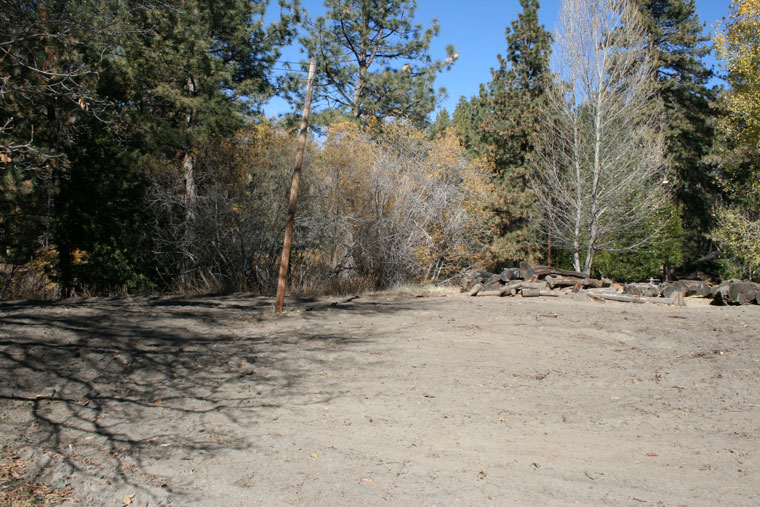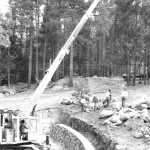
Photo by Marshall Smith
Pickleball, one of the fastest-growing new sports in the U.S., has found a footing in Idyllwild. However, finding a permanent home for pickleball courts and players may prove harder. An online poll of Idyllwild residents revealed confusion over facts and growing opposition to planned installation of pickleball courts at the Idyllwild County Park.
As background, on Thursday, Nov. 3, the Riverside County Park District Advisory Commission authorized building the courts in a yet-to-be-determined location at the county park in Idyllwild. “Three courts will be installed at the county park, as a park district amenity,” said Riverside County Regional Park and Open Space District Recreation Bureau Chief Kyla Brown at the time.
The proposed courts at the county park are not part of either tax-funded County Service Area 36 community recreation or the Idyllwild Community Center. As Brown specified, they are intended to be a county-maintained recreation amenity. Funding for the courts is to come from two sources — $25,000 from the Park and Open Space District and $20,000 from several ICC donors.
ICC’s involvement with pickleball was initially gratuitous. Pine Cove resident and sports enthusiast Barry Wallace proposed to ICC to allow already-constructed tennis courts on the ICC site to be used occasionally as pickleball courts with Wallace providing the expertise to construct provisional courts. ICC acquiesced. “My goal from the very beginning was to support a game that many on the Hill could play,” said Wallace. “I put the courts in on an existing tennis court knowing that plans for ICC construction would remove those courts.”
Noting that the provisional courts on the ICC site had attracted 30 to 50 players on a regular basis and that ICC construction would remove those courts, Wallace proposed to CSA 36 recreation, currently managed by the Park and Open Space District, to have permanent courts installed at the county park site.
With the Nov. 3 approval of the courts by the commission, public controversy began to grow. Few residents had attended the CSA 36 meetings at which the courts had been discussed and approved.
Idyllwild resident Charles Phelan started an online poll regarding the courts since many, like Phelan, who walk their dogs in the county park, had not heard that pickleball courts had been considered and approved for installation at the county park. “I put the poll out there because no one I had talked to knew about the courts,” said Phelan. “I thought, ‘hold on a minute,’ let’s just find out the facts.”
The poll revealed confusion and misunderstanding about the process and underlying facts.
On Monday, Dec. 12, in response to Town Crier inquiries, Brown offered clarification as to the current status of the project and facts at this point:
- “The plan is still in the very early stages. As such, the exact location [at the county park] has yet to be determined. Once the project is farther along, [a plan for] community involvement will be determined.”
>
- “All projects undergo a review as required by CEQA.” The California Environmental Quality Act is a statute that requires state and local agencies to identify the significant environmental impacts of their actions and to avoid or mitigate those impacts, if feasible.”
>
- “The area [some thought was being graded in preparation for court installation] is being cleaned up in the normal course of business, and is not related to the project in any way. That area [near the creek where large logs are stacked] is not being cleared in prep for pickleball courts.”
>
- “I’ll look into the ‘meadow’ questions.”
What Brown was referring to regarding the “meadow” questions was whether any particular area at the county park had ever been designated as an environmentally or archeologically sensitive meadow wetlands area by an environmental impact report. Also, whether that area has been mapped and specifically demarked as an area on which recreational activity should be limited because of potential for environmental degradation. And even if no existing report had yet indentified a specific area of potential wetlands sensitivity, would the planned CEQA study do so and would the meadow then be clearly delineated?
Some who use the park view current “mow” lines as meadow borders. Park personnel and Brown confirm those mow lines are completely arbitrary. In the past, the area referred to as the “meadow” has been totally mowed. Festivals also have been held in the county park, including a Bluegrass Festival and a Timberfest that ran for nearly 10 years in the 1990s.
As Phelan and others have noted, if the meadow is an environmentally sensitive area, it should be clearly demarked. Also, Phelan and others believe the county should clearly designate the sites where the courts could be installed and allow a public comment period prior to proceeding.
Brown indicated those community concerns would be considered, an environmental impact report undertaken, meadow boundaries defined if it is identified as environmentally or archeologically sensitive, and a public comment period and/or meeting held prior to any pickleball court construction.
Wallace said, “I’m hopeful we can make something happen [for Hill pickleball players] without stepping on anyone’s toes. We’ll just have to wait and see.”
In referring to a letter to the editor from Peter Davison, Wallace said, “The person got the wrong information. If the facts were as he said, I would be against it [construction of the courts].” In his letter, Davison stated he had been told by a worker at county park that ICC was “dumping” the courts on the county park, the parking lot would be enlarged into the meadow, fencing and paving around the entire meadow would be undertaken and that an existing pathway through the area and adjoining woods was scheduled to be paved. Davison said later the worker was a bulldozer operator.
Brown clarified that the proposed courts have nothing to do with ICC, and that paving and fencing, as Davison had written, is not planned. “We rely on volunteers at the park and it’s possible someone gave Mr. Davison the wrong information,” she noted.
She also stressed that the only reason her agency was considering the courts was at the request of community members. “The whole reason we were even looking at this is based on the community’s request and because we were told that Town Hall would not be an appropriate site for the courts.”
Brown also emphasized that the CEQA process would address all meadow wetland concerns including trees, animals, species and ecologically sensitive areas in proximity to the proposed project.
When asked if pickleball would return at any time in the future to the ICC site, Spokesperson Chris Trout said, “No. In none of the four phases would there be room.” Construction of the buildings and parking will consume most of the flat land needed for courts of any sort.











While very much disturbed and full of non-native plant species it is still a place where some native species reside that can be found nowhere else in the park such as checkerbloom and slender cinquefoil. Keeping with the spirit of the natural elements of the park, it was my hope that someday it could be restored to its former natural splendor, but apparently there are still some who insist on exerting their dominion over even the few natural preserved spaces that remain.